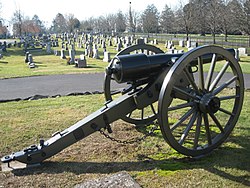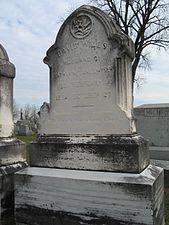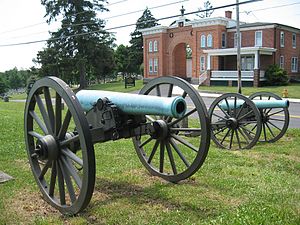| Evergreen Cemetery | |
|---|---|
 Ginnie Wade Monument, location of platform for Gettysburg Address and Soldiers National Monument (L to R) are marked on the horizon. The oldest section (A) of the cemetery appears behind the Parrott rifled cannon. Ginnie Wade Monument, location of platform for Gettysburg Address and Soldiers National Monument (L to R) are marked on the horizon. The oldest section (A) of the cemetery appears behind the Parrott rifled cannon. | |
| Details | |
| Established | 1854 |
| Location | Cumberland Township, Adams County, Pennsylvania |
| Country | United States |
| Coordinates | 39°49′08″N 77°13′49″W / 39.8189770°N 77.2302596°W / 39.8189770; -77.2302596 |
| Size | 17.65 acres (7.14 ha) |
| Find a Grave | Evergreen Cemetery |
Evergreen Cemetery – formerly called Citizen's Cemetery and Ever Green Cemetery – is a historic 29.12 acre rural cemetery located just outside Gettysburg Borough, in Cumberland Township, Adams County, Pennsylvania, United States. It is part of Gettysburg Battlefield Historic District, and is surrounded by Gettysburg National Military Park and Soldiers' National Cemetery.
The cemetery played a strategic role in the July 1 to 3, 1863 Battle of Gettysburg. Four months after the battle, at the dedication of the immediately-adjacent National Cemetery, President Abraham Lincoln delivered his "Gettysburg Address" from a platform in Evergreen Cemetery.
History
Founding
The Ever Green Cemetery Association of Gettysburg was established at a November 29, 1853 meeting. The association managed the property and oversaw selection of its caretakers. By April 3, 1854, 118 lots had been sold, and the association members' first payments were due. The first interment took place on October 29. Opening ceremonies were held on November 7, 1854, and in his dedication address Reverend John H. C. Dosh asked, "Could a more lovely spot have been chosen?"
The Evergreen Cemetery gatehouse was designed by Philadelphia architect Stephen Decatur Button, built by local contractors George and Henry Chritzman, and completed in November 1855. The Italianate gatehouse served as the caretaker residence.
Battle of Gettysburg
Main article: Battle of Gettysburg
Evergreen Cemetery is eponymous with Cemetery Hill, the landform noted as the keystone of the Union position during the Battle of Gettysburg. Major-General Oliver Otis Howard lined the cemetery's high ground with cannons, turning it into an "artillery platform," and made its gatehouse into XI Corps (Union Army) headquarters.
At dusk on July 2, 5 Louisiana regiments under Brigadier-General Harry T. Hays and 3 North Carolina regiments under Colonel Isaac E. Avery commenced the Battle of East Cemetery Hill, charging Howard's artillery batteries from the east. "Federal soldiers in the Cemetery laid many of the tombstones on the ground" to limit damage, and some of the XI Corps batteries and infantry used the grave monuments "for shelter from the enemy's fire". Historian Frederick Hawthorne wrote of Howard's successful defense: “Lying in reserve in the Evergreen Cemetery, they (73rd Pennsylvania Infantry) rushed out through the cemetery gateway to help drive the Confederates away from Rickett’s and Weidrich’s batteries.”
Evergreen experienced three days as battlefield, and its resulting condition inspired a Union officer to lament: "A beautiful cemetery it was, but now is trodden down, laid a waste, desecrated. The fences are all down, the many graves have been run over, beautiful lots with iron fences and splendid monuments have been destroyed or soiled, and our infantry and artillery occupy those sacred grounds where the dead are sleeping. It is enough to make one mourn."
Two Confederate soldiers mortally wounded during the battle were buried in Evergreen Cemetery.
Post-battle

The Consecration of the National Cemetery at Gettysburg took place on November 19, 1863. The speaker's platform used by orator Edward Everett, and then by President Abraham Lincoln to deliver his Gettysburg Address, was located just east of the National Cemetery, on the grounds of Evergreen Cemetery.
From 1893 to 1916, the Gettysburg Electric Railway operated along the cemetery's east and south borders. Following the 1917 demolition of the trolley railway, Evergreen Cemetery expanded southward.
In 1972, the "Evergreen Cemetery archway house" was designated an historic district contributing structure by the Gettysburg Borough Council (1 of 38 outside of the borough). Civilian remains at the site of the 1804 Associate Reformed Presbyterian Church cemetery were reinterred at Evergreen Cemetery in 1992.
Photo gallery
-
 Gatehouse
Gatehouse
-
 The only published photographic analysis places the site of the platform for the Gettysburg Address at the graves of George Kitzmiller, Israel Yount and John Koch.
The only published photographic analysis places the site of the platform for the Gettysburg Address at the graves of George Kitzmiller, Israel Yount and John Koch.
-
 Ginnie Wade, lone civilian casualty of the Battle of Gettysburg
Ginnie Wade, lone civilian casualty of the Battle of Gettysburg
-
 John L. Burns, geriatric civilian combatant at the Battle of Gettysburg
John L. Burns, geriatric civilian combatant at the Battle of Gettysburg
-
 Esaias Jesse Culp's headstone shows battle damage.
Esaias Jesse Culp's headstone shows battle damage.
-
 Frederick Huber's headstone shows battle damage.
Frederick Huber's headstone shows battle damage.
-
 Maurey headstone shows battle damage.
Maurey headstone shows battle damage.
-
 McPherson's obelisk was laid over by Union troops.
McPherson's obelisk was laid over by Union troops.
-
 Smyser's obelisk was laid over by Union troops.
Smyser's obelisk was laid over by Union troops.
-
 Some 69 Union battle casualties remain permanently.
Some 69 Union battle casualties remain permanently.
-
 Confederate casualty cenotaphs. Due to local outrage, the remains were re-located to unmarked locations.
Confederate casualty cenotaphs. Due to local outrage, the remains were re-located to unmarked locations.
-
 At six months pregnant, Elizabeth Thorn acted as caretaker in her husband's absence and buried more than 100 casualties. Peter Thorn served in the 138th PA Volunteers.
At six months pregnant, Elizabeth Thorn acted as caretaker in her husband's absence and buried more than 100 casualties. Peter Thorn served in the 138th PA Volunteers.
-
 David Wills organized and executed the adjacent National Cemetery.
David Wills organized and executed the adjacent National Cemetery.
-
 Stewart's Battery straddled the Baltimore Pike, just north of the Gatehouse.
Stewart's Battery straddled the Baltimore Pike, just north of the Gatehouse.
See also
References
- "General Gettys' Grandson Here" (Google News Archive). The Gettysburg Times. September 5, 1923. Retrieved February 26, 2012.
- Skelly, Daniel Alexander (1999) . A Boy's Experiences During the Battle of Gettysburg. Archived from the original on December 22, 2010.
Reaching the Citizens Cemetery we found a battery of artillery posted there… The soldiers stopped us and would not let us pass.
- Linden, Blanche M.G. (2007). Silent City on a Hill: Picturesque Landscapes of Memory and Boston's Mount Auburn Cemetery. Amherst, Massachusetts: University of Massachusetts Press. p. 294. ISBN 978-1-55849-571-5. Retrieved August 10, 2019.
- Adams County. "Public Interactive GIS Mapping". Parcel ID: 09F13-0150---000. Archived from the original on November 28, 2012. Retrieved July 1, 2012.
- Historical Marker Database. "The Gettysburg Address". Retrieved May 5, 2013.
- National Park Service. "National Cemetery Walking Tour" (PDF). Retrieved May 5, 2013.
- Beitel, Calvin Gustavus (1874). A Digest of Titles of Corporations Chartered by the Legislature…. J. Campbell & son. Retrieved November 22, 2011 – via Internet Archive.
For the Senate bill committed earlier, see "Ever Green Cemetery" (Google News Archive). The Adams Sentinel. February 6, 1854. Retrieved July 16, 2011.On Tuesday last, in the Senate of Pa., Mr. McClintock, from the Committee on Corporations, reported, as committed, the bill to incorporate the Ever Green Cemetery Association of Gettysburg
- "Article". The Adams Sentinel. April 3, 1854.
- ^ "Public Cemetery" (Google News Archive). The Star and Sentinel. April 22, 1880. Retrieved January 18, 2012.
- Alfred L. Brophy, "The Road to the Gettysburg Address," Florida State University Law Review 43 (2016):831.
- Kennell, Brian A. "Gatehouse Miniatures". EvergreenCemetery.org. Archived from the original on July 20, 2011. Retrieved October 12, 2011.
- "East Cemetery Hill – Gettysburg, PA". American Guide Series on Waymarking.com. Retrieved February 26, 2012.
- Pfanz, Harry (1993). Gettysburg-Culp's Hill & Cemetery Hill. Chapel Hill, North Carolina: The University of North Carolina Press. p. 263. ISBN 978-0-8078-2118-3.
- Barnett, Bert H. ""Our Position Was Finely Adapted To Its Use"-The Guns of Cemetery Hill" (PDF). Gettysburg Seminars. National Park Service. Retrieved March 9, 2013.
- "Gen. Howard's Best Supper: Back to Gettysburg to Thank Mrs. Thorn 39 Years Later" (Google News Archive). Easton Daily Free Press. September 25, 1902. Retrieved October 12, 2011.
meal was eaten rather late on the night of July 1st, in the Evergreen Cemetery house,… which was the headquarters of General Howard from the evening of the first day's battle until the close, and was partaken of by…General Howard,…General Sickles and…General Slocum.
- "Battle of Gettysburg" (Google News Archive). The Compiler. July 20, 1863. Retrieved February 26, 2012.
- Haskell, Frank A. (2006) . The Battle of Gettysburg (Google books) (reprint ed.). Kessinger Publishing. p. 22. ISBN 978-1-4286-6012-0. Retrieved March 8, 2012. The Eleventh Corps…was posted at the Cemetery, some of its batteries and troops, actually among the graves and monuments, which they used for shelter from the enemy's fire … rifled guns in the Cemetery, at the left of the Eleventh Corps, opened fire—almost the first shots of any kind this morning…at a Rebel line of skirmishers
- Hawthorne, Frederick W., Gettysburg: Stories of Men and Monuments, Hanover, Pennsylvania: The Association of Licensed Battlefield Guides, 1988, p. 107.
- Pfanz, Harry (1993). Gettysburg-Culp's Hill & Cemetery Hill. Chapel Hill, North Carolina: The University of North Carolina Press. pp. 263–283. ISBN 978-0-8078-2118-3.
- Bill Neil (July 11, 1990). "Confederate soldiers get headstones 127 yrs later". Gettysburg Times.
- National Park Service. "National Cemetery Walking Tour" (PDF). Retrieved December 15, 2012.
- "Borough of Gettysburg …historic crossroads". Borough Office. Archived from the original on June 12, 2011. Retrieved April 11, 2011.
- "List 38 More Properties In Historic Area". The Gettysburg Times. April 15, 1972. Retrieved March 18, 2012 – via Google News Archive.
- "Chapter XXX: Cumberland Township". History of Cumberland and Adams Counties, Pennsylvania: Part III, History of Adams County. Chicago: Warner, Beers & Co. 1886. pp. 236–247. Retrieved March 5, 2012.
- Bartlett, Joanne (June 10, 1995). "Remains from 16 old graves on Ice House Property reburied". Gettysburg Times. Retrieved February 25, 2012.
The remains included six adults, nine children and one adult. …discovered in the spring of 1992 when at the former church site.
- Frassanito, William A. (1995). Early Photography at Gettysburg. Gettysburg, PA: Thomas Publications. pp. 160–167. ISBN 0939631865.
Further reading
- Brian A. Kennell (2000). Beyond the Gatehouse: Gettysburg's Evergreen Cemetery. ISBN 978-0-9664772-0-7.
External links
- Evergreen Cemetery Tour is a seventeen-part, comprehensive, audio-visual introduction to this subject by Debra A. Novotny, who has served both as a Licensed Battlefield Guide and as a boardmember of the Evergreen Cemetery Association.
- U.S. Geological Survey Geographic Names Information System: Evergreen Cemetery
- Evergreen Cemetery at Find a Grave
